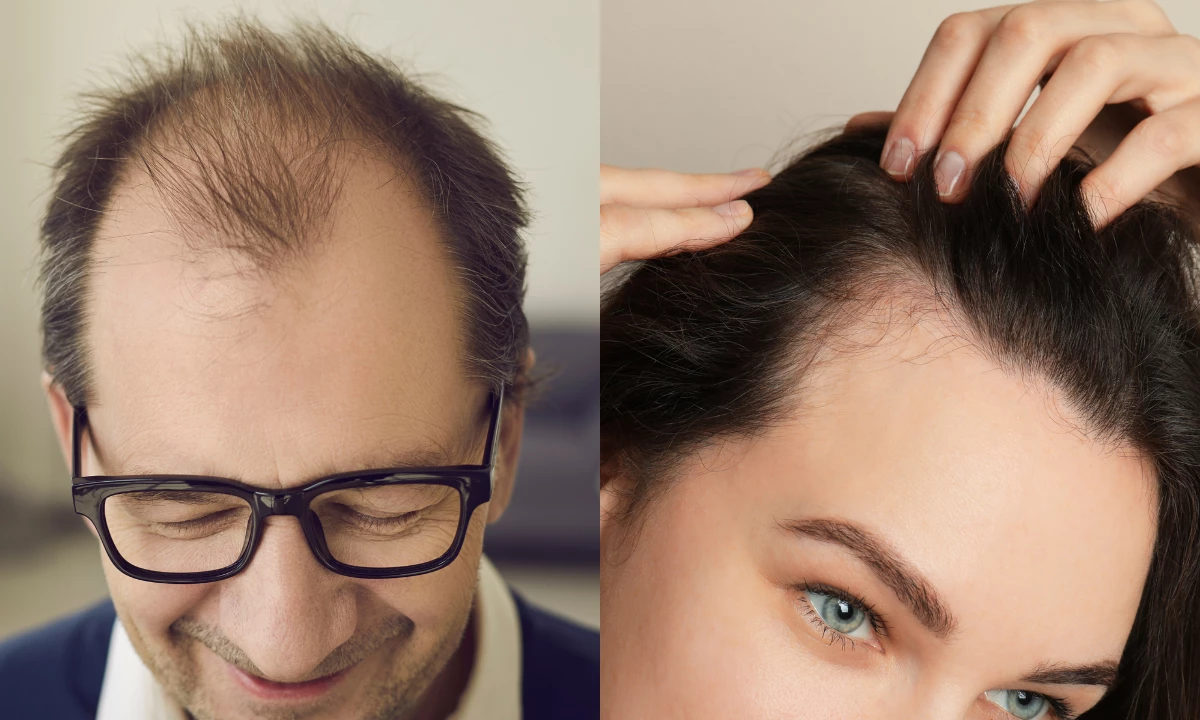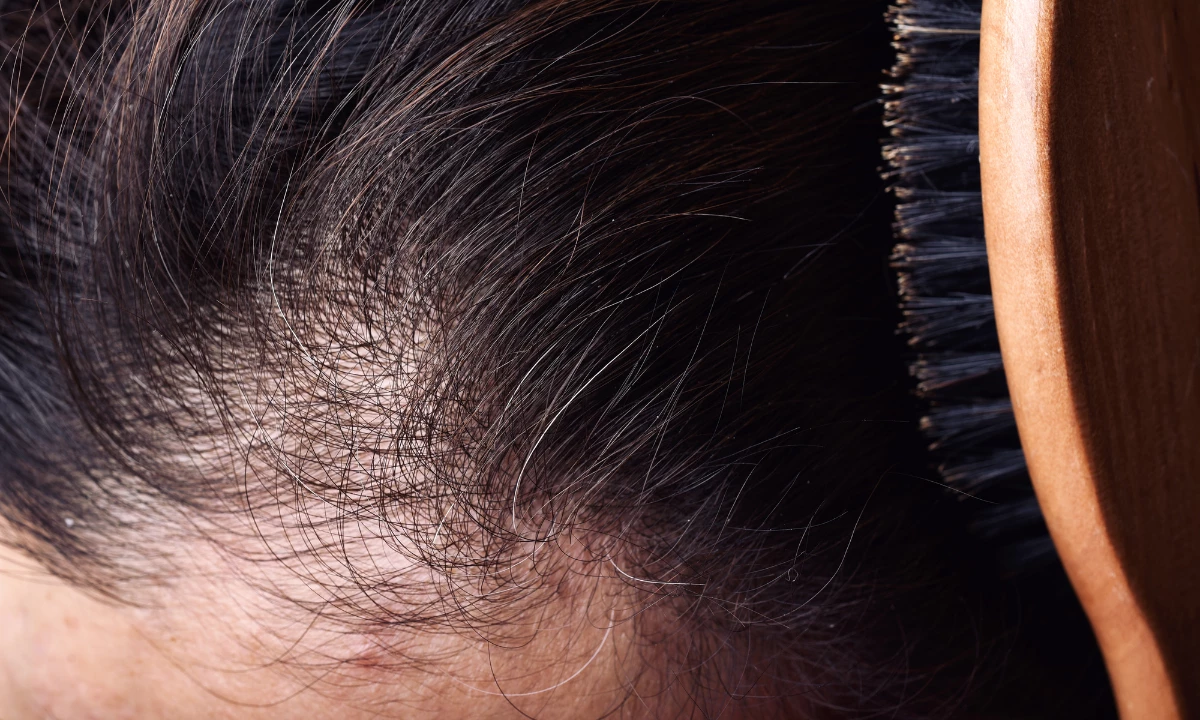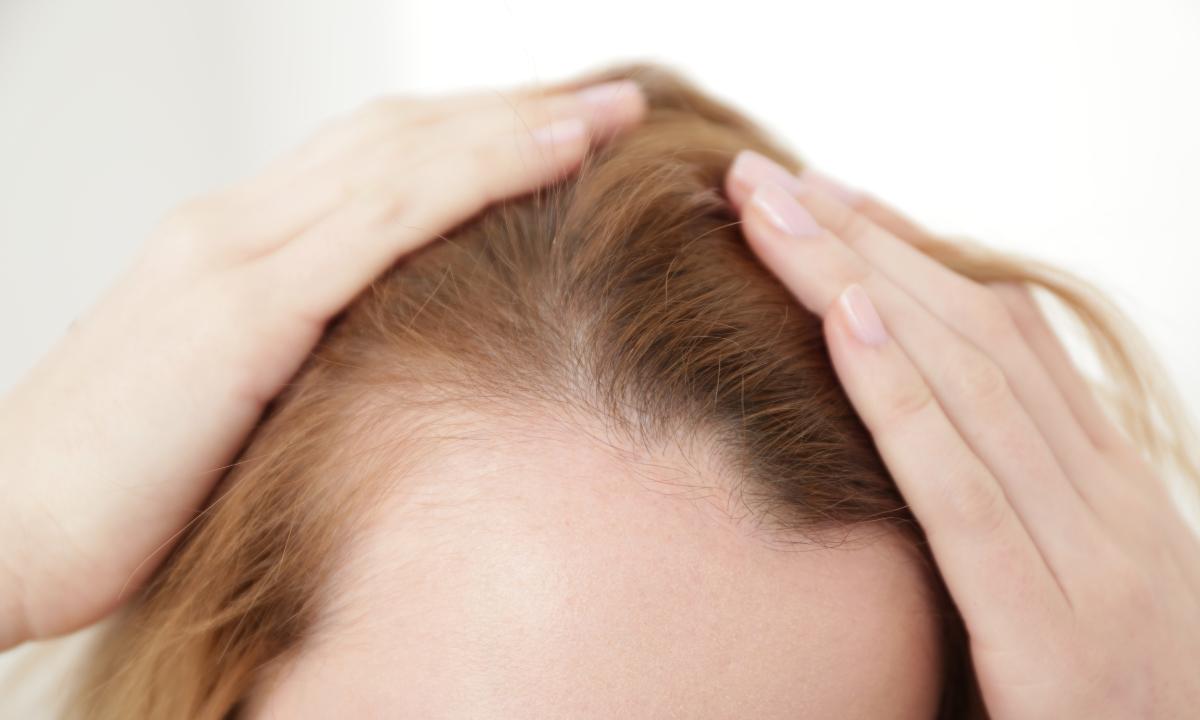A receding hairline is more than a physical shift; it’s a journey that many navigate with uncertainty. In this article, we explore the multifaceted aspects of a receding hairline, aiming to empower and guide individuals toward embracing their unique transformations.
Understanding Receding Hairline
A receding hairline is more than just a cosmetic concern; it’s a complex interplay of genetic predispositions, hormonal imbalances, and lifestyle influences. This phenomenon, which is characterized by a gradual receding hairline, affects people, whether male or female, and often raises concerns about appearance and self-confidence.
Exploring the causes, identifying symptoms, and discovering effective management strategies are pivotal steps toward addressing and navigating the challenges associated with a receding hairline.
Causes of Receding Hairline

A receding hairline can stem from various factors, often a blend of genetic predispositions and external influences:
- Genetic Factors: Hereditary patterns play a pivotal role in determining hairline recession. If one or both parents experienced this issue, there’s a higher likelihood of inheriting a similar pattern.
- Hormonal Influences: Hormonal imbalances, particularly an excess of dihydrotestosterone (DHT), contribute significantly to hair thinning and receding. DHT can shrink hair follicles, leading to a receding hairline.
- Lifestyle and Environmental Factors: External elements like stress, poor nutrition, smoking, and exposure to pollutants can accelerate hair loss and contribute to a receding hairline. Environmental stressors can weaken hair follicles, causing them to shrink over time.
Understanding these causes provides a foundation for addressing and managing a receding hairline effectively.
Signs and Symptoms

A receding hairline manifests through distinct signs, aiding in its identification and understanding.
Identifying a Receding Hairline
- Temple Recession: One of the initial signs involves the gradual thinning of hair along the temples. Hair begins to recede, creating a more pronounced “M” shape at the frontal hairline.
- Sparse or Thinning Hair: The affected area experiences a reduction in hair density, leading to a visible thinning at the front of the scalp.
- Visible Scalp: As the hairline recedes further, the scalp becomes more noticeable, accentuating the recession.
Different Stages of Hairline Recession
Hairline recession progresses through stages, categorized based on the severity of the recession:
- Early Stage: Mild recession is noticeable, primarily around the temples, marking the onset of a receding hairline.
- Moderate Stage: The hairline recedes further, forming a more defined “M” shape and becoming more apparent.
- Advanced Stage: Severe recession results in a deeper “M” shape, with substantial hair loss at the front of the scalp.
Understanding these signs and stages is crucial for timely identification and appropriate management of a receding hairline.
Home Remedies and Natural Treatments

Exploring natural alternatives can complement conventional treatments and promote healthier hair growth.
Herbal Supplements and Essential Oils
- Herbal Supplements: Supplements like saw palmetto, ginseng, and biotin are believed to support hair health and may help slow down hair loss associated with a receding hairline.
- Essential Oils: Oils such as rosemary, peppermint, and lavender have the potential to stimulate hair growth and improve scalp health. Massaging these oils into the scalp can enhance blood circulation and promote hair follicle health.
DIY Hair Masks and Scalp Treatments
- Egg and Olive Oil Mask: A mixture of eggs and olive oil applied to the scalp and hair can nourish the follicles, promoting strength and luster.
- Aloe Vera Gel: Aloe vera possesses soothing properties and can be applied directly to the scalp to alleviate inflammation and promote a healthier scalp environment for hair growth.
- Coconut Oil and Honey Treatment: A blend of coconut oil and honey acts as a natural conditioner, moisturizing the scalp and hair strands, potentially reducing breakage and supporting healthy growth.
Utilizing herbal supplements, essential oils, and DIY treatments can complement conventional approaches, offering natural support for a healthier scalp and potentially aiding in managing a receding hairline.
Lifestyle Adjustments for Hairline Health
Making conscious changes in styling habits and dietary choices can significantly impact hair health and potentially slow down the progression of a receding hairline.
Styling Tips for Receding Hairline
- Opt for Suitable Hairstyles: Embrace hairstyles that complement a receding hairline, such as shorter cuts or styles that add volume. Avoiding tight hairstyles and excessive pulling can reduce stress on fragile hair.
- Use Gentle Styling Techniques: Limit the use of heat styling tools and opt for gentler methods to style hair. Patting hair dry with a soft towel instead of vigorous rubbing can prevent unnecessary hair breakage.
- Consider Hair Accessories: Using headbands or scarves strategically can help cover or draw attention away from a receding hairline, providing both style and practicality.
Dietary Modifications for Hair Growth
- Balanced Nutritional Intake: Incorporate into your diet foods rich in essential nutrients like vitamins (A, C, E), biotin, iron, and omega-3 fatty acids. These nutrients support overall hair health and growth.
- Hydration: Adequate water intake is crucial for maintaining scalp health. Staying hydrated contributes to a healthier scalp environment for hair growth.
- Supplements if Necessary: Consider consulting a healthcare professional for advice on dietary supplements that can support hair health if your diet lacks specific nutrients.
By adopting suitable styling techniques and making dietary adjustments, individuals can actively promote better hair health and potentially manage the effects of a receding hairline more effectively.
Professional Help and Consultation
Navigating a receding hairline often involves seeking guidance from qualified professionals to explore treatment options and develop personalized plans.
Finding the Right Hair Specialist
- Research and Recommendations: Begin by researching reputable hair specialists or dermatologists experienced in treating hair loss. Seek recommendations from trusted sources or healthcare providers.
- Credentials and Expertise: Look for specialists with expertise in treating receding hairlines. Consider their credentials, experience, and reviews from previous patients to gauge their suitability.
- Initial Consultation: Schedule initial consultations with potential specialists to discuss concerns about treatment approaches and assess their understanding of your specific needs.
Consultation Process and Treatment Plans
- Assessment and Diagnosis: During consultations, the specialist will likely conduct a thorough examination to diagnose the extent and underlying cause of the hairline recession.
- Treatment Options: Based on the assessment, the specialist will propose treatment options tailored to your condition. They’ll explain the available interventions, their efficacy, and potential side effects.
- Developing a Treatment Plan: Collaborate with the specialist to create a comprehensive treatment plan aligned with your preferences and goals. This plan may include a combination of medical, surgical, or lifestyle-based approaches.
Seeking professional guidance is pivotal in understanding available treatments and crafting an individualized approach to managing a receding hairline effectively.
Impact on Mental Health
The ramifications of a receding hairline extend beyond physical changes, significantly impacting an individual’s mental and emotional well-being.
Psychological Effects of Receding Hairline
- Self-Esteem and Confidence: A receding hairline often leads to a decline in self-esteem, affecting one’s confidence and self-image. Individuals may experience heightened self-consciousness about their appearance.
- Psychological Stress: The pressure to conform to societal beauty standards or personal perceptions can cause stress, anxiety, and depression due to noticeable changes in appearance.
- Social Implications: The emotional distress caused by a receding hairline can influence social interactions, leading to withdrawal or avoidance of social situations.
Coping Strategies and Support
- Self-Acceptance and Positive Mindset: Encouraging self-acceptance and fostering a positive mindset are crucial. Embracing personal attributes beyond physical appearance can bolster self-esteem.
- Seeking Support: Open communication with friends, family, or a support group can provide emotional solace and understanding. Seeking professional guidance from counselors or therapists can also aid in coping with the emotional impact.
- Exploring Treatment Options: Exploring treatment options, whether medical or cosmetic, can empower individuals to take proactive steps toward managing their receding hairline, potentially alleviating psychological distress.
Understanding the psychological effects and implementing coping strategies can significantly mitigate the emotional toll of a receding hairline.
Preventive Measures
Addressing a receding hairline often involves a combination of lifestyle adjustments and medical interventions to manage and potentially slow down the progression.
Lifestyle Changes for Hair Health
- Balanced Diet: A nutrient-rich diet with leafy greens, nuts, fish, and lean proteins helps maintain healthy hair.
- Stress Management: Stress can exacerbate hair loss. Adopting stress-reduction techniques like meditation, yoga, or engaging in hobbies can positively impact hair health.
- Gentle Hair Care: Avoiding harsh treatments and practices like excessive heat styling, tight hairstyles, and rough handling can prevent further damage to fragile hair.
Medical Interventions and Treatments
- Topical Solutions: Minoxidil and other topical treatments widen hair follicles, prolong the growth phase, and stimulate hair growth while slowing hair loss.
- Oral Medications: Finasteride reduces hair loss by blocking testosterone conversion to DHT.
- Surgical Options: For those seeking more permanent solutions, surgical interventions like hair transplants or scalp reduction surgery can restore a more natural-looking hairline.
Combining these lifestyle changes with medical interventions offers a holistic approach to managing and potentially preventing further progression of a receding hairline.
Addressing a receding hairline early holds significant importance for several reasons:
- Preserving Existing Hair: Early intervention can help preserve the existing hair and potentially slow down the progression of hair loss. It might be easier to manage and maintain the remaining hair rather than attempting to regrow lost hair later on.
- Increased Treatment Effectiveness: Starting treatment early can yield better results. Certain medications and interventions are more effective when implemented during the initial stages of hair loss, potentially preventing further recession.
- Boosting Self-Confidence: Hair loss can have a profound impact on self-esteem and confidence. Addressing it early allows individuals to take control, explore treatment options, and manage the emotional impact associated with changes in appearance.
- Wider Range of Options: Early intervention provides access to a broader range of treatment options. It allows for the exploration and implementation of various methods—medical, surgical, or lifestyle changes—providing more choices for managing a receding hairline.
- Reducing Psychological Distress: Timely management can alleviate the emotional burden associated with hair loss. It aids in reducing stress and anxiety, and the potential social impact is often linked to changes in one’s physical appearance.
By addressing a receding hairline early, individuals can proactively manage hair loss, potentially slow down its progression, and positively impact both their physical appearance and emotional well-being.
Encouragement for Taking Action and Seeking Help
Facing a receding hairline can be daunting, but taking proactive steps toward addressing it is empowering. Seeking help from healthcare professionals, dermatologists, or specialists who understand hair loss can open doors to effective solutions.
Remember, you’re not alone in this journey. Embracing change, exploring available treatments, and seeking support from experts can lead to meaningful improvements in managing your hairline. Taking that first step towards seeking guidance can pave the way for regaining confidence and control over your appearance.
Your decision to seek help signifies strength and self-care. By reaching out, you’re investing in your well-being and setting the stage for potential positive transformations. Don’t hesitate to take that step; the journey to managing a receding hairline starts with seeking assistance and support. You deserve to feel confident and comfortable in your own skin.
Receding Hairline FAQs
Can receding hairline grow back?
Hair loss due to a receding hairline can be managed with treatments that may slow down or stop further recession, but regrowth of hair in the affected areas might be limited. Early intervention with proper treatments can sometimes stimulate regrowth to a certain extent, especially if the hair follicles are not permanently damaged.
Can you fix a receding hairline?
Various treatments, including medications, topical solutions, surgical interventions like hair transplants, and lifestyle adjustments, can help manage and sometimes slow down the progression of a receding hairline. Consulting with a specialist can provide insight into suitable options based on individual circumstances.
Why is my hairline receding at 14?
Young receding hairlines can be genetic, hormonal, or health-related. Seek medical advice for proper diagnosis and treatment.
Can your hairline recede at 18?
Hairline recession at 18 can occur due to genetic predisposition, hormonal changes, stress, or lifestyle factors. It’s not uncommon for individuals to experience some degree of hairline recession during late adolescence.
Why is my hair receding at 17?
Hairline recession at 17 can be due to genetics, hormones, stress, or health issues. Consult a healthcare professional or dermatologist for diagnosis and treatment options.
Why is my hairline receding at 16?
Hairline recession at 16 can be linked to genetic predisposition, hormonal changes during puberty, or other factors impacting hair health. Seeking guidance from a healthcare provider can aid in understanding the cause and exploring management options.
How can I regrow my hairline?
Treatments like minoxidil, finasteride, hair transplants, and lifestyle changes can help regrow a receded hairline. Consult a healthcare professional for suitable options.
Will I be bald if my dad is?
Genetics plays a role in hair loss patterns. A bald father doesn’t guarantee hair loss. Multiple genetic factors from both sides of the family determine hair loss.
Is it rare to be bald at 16?
Experiencing balding at 16 can be uncommon, but it’s not unheard of. Hair loss at a young age can be distressing and may signify underlying health conditions or genetic predispositions that need evaluation by a healthcare professional.
How do I know I’m balding?
Signs of balding include a receding hairline, thinning of hair on the crown or temples, increased shedding, and visible scalp. Consulting with a dermatologist or hair specialist for a comprehensive evaluation can confirm if you’re experiencing balding.
Is it OK to go bald at 17?
Experiencing balding at 17 can be emotionally challenging, but it’s essential to understand that it’s a natural process for some individuals. Seeking support, exploring treatment options, and embracing self-acceptance can help you navigate this change positively.
Conclusion
Embracing a receding hairline involves understanding its complexities and impacts, from genetic factors to psychological effects. Seeking early intervention and exploring various treatments is crucial for preserving hair and boosting confidence. This journey isn’t just about managing hair loss; it’s an empowering path towards self-acceptance and proactive care. By taking steps to address a receding hairline, individuals embark on a journey of resilience, self-discovery, and empowerment, fostering a positive relationship with oneself.

